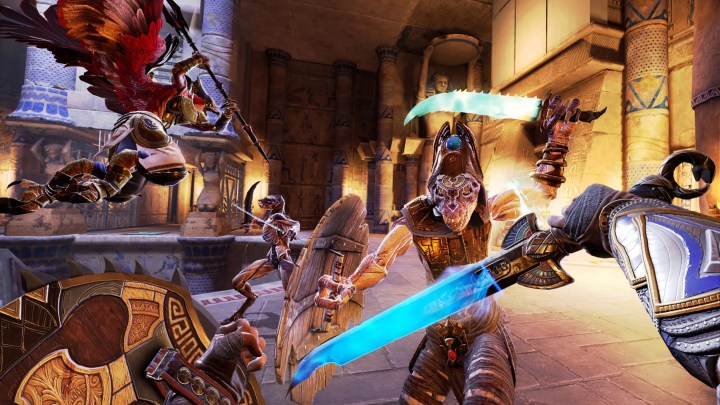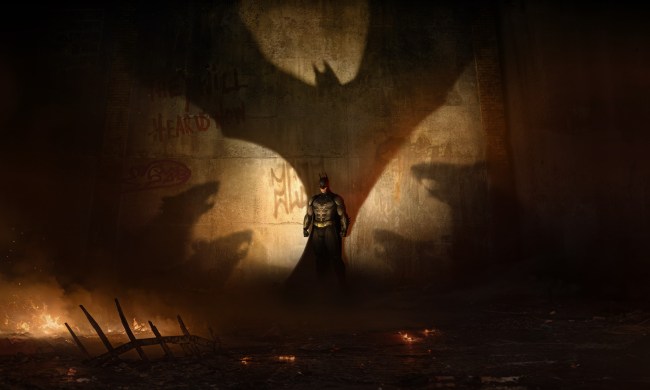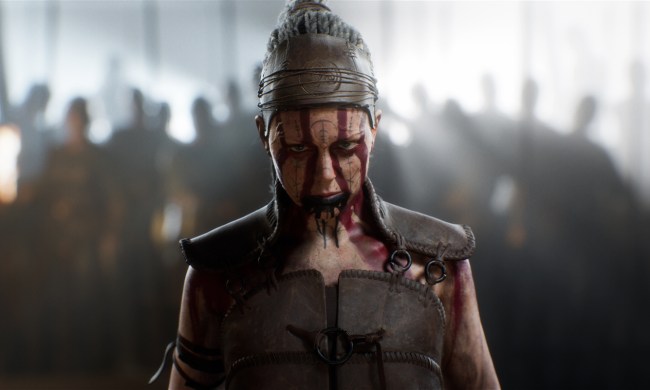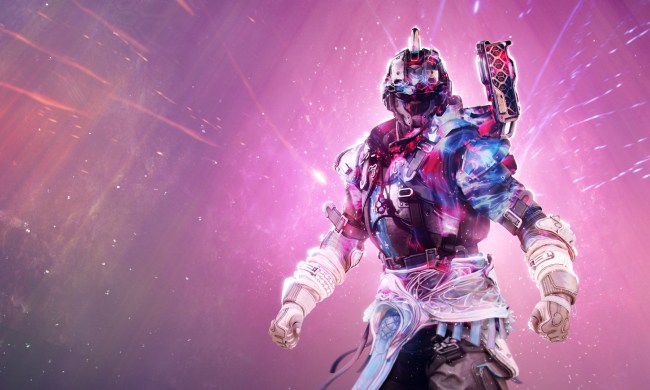I still distinctly remember my first experience playing a video game in VR. I was working at Rolling Stone when HTC came to the office to demo several experiences on its Vive headset. After playing some basic arcade games, I commented that I could really feel that the tech was in its Atari era. The simple game design made it clear that this was just the beginning for VR gaming, and that I shouldn’t expect it to match console gaming anytime soon. It was an experimental ride I was ready to take.
Playing Asgard’s Wrath 2 on a Meta Quest 3 one decade later, it feels like I’ve jumped 30 years into the future. Though games like Horizon: Call of the Mountain and Half-Life Alyx have delivered similarly impressive adventures over the past few years, Meta’s big exclusive takes the tech to a new peak. If those early games I played in my first VR demo were analogous to Atari 2600 games, this enormous RPG sequel takes me all the way to the Xbox 360 era. That’s a quantum leap forward in just 10 years.
While I’ve only scratched the surface of what it has to offer so far, Asgard’s Wrath 2 delivers a true killer app for Meta’s headsets. It’s a complex action-RPG with everything I’d expect from a modern console game, though one that’s still easy to understand thanks to sharp and intuitive controls. It’s a crowning moment for this era of VR, but Meta won’t be able to rest on that accomplishment for long. Dated storytelling and design makes it clear that the race up the mountain isn’t over; it’s just kicking into another gear.
Reaching the pinnacle
As someone who missed out on the series’ first game, Asgard’s Wrath 2 can be very overwhelming out the gate. I’m thrust into a God-filled story that’s already four layers deep into its lore by the time I boot it up. I have no idea what’s going on other than the fact that I need to traverse the universe in search of Loki. Before I can unpack the nuances of that narrative, I’m thrown into the fire in an awe-inspiring boss battle against a giant bird that teaches me the basics of slashing. My next few hours are spent rummaging through menus as I learn to drag perks onto my gear, unlock new skills, juggle quests and bounties, navigate maps full of activities, and craft items.

It’s not a game for VR newcomers, but rather comfortable experts who are ready to take the training wheels off. To developer Sanzaru Games’ credit, though, the studio knows exactly what works in VR and what doesn’t. Rather than messing around with complicated control ideas, every motion I make feels natural enough that I don’t need to spend much time learning how to exist in this sweeping digital world. It’s not long before I’m opening chests, grabbing resources, and chucking my ax at switches without thinking about how to pull those moves off first.
It’s when I easily take to its motion controls that I realize Asgard’s Wrath 2 is a culmination of an experimental era for VR gaming. In early puzzle dungeons, I find myself able to navigate smoothly as I run across walls and pull my way up ladders without much technical friction. It’s especially fine-tuned next to something like Horizon Call of the Mountain, which tries to push its ambitions with more complicated motions that turn combat into a finicky mess of confusing motions. Asgard’s Wrath 2 does have complexity of its own, but it builds to it more gradually, making me more comfortable with new ideas before introducing additional ones. An early puzzle teaches me how to grab chains and hook them onto set objects. A few hours later, after gaining the ability to transform green air into traversable objects, I’m completing more involved puzzles that have me combining those two learnings.
I can feel how everything from The Climb to Moss built to this moment. For instance, that game’s DNA can clearly be felt in Asgard’s Wrath 2’s God-perspective puzzle segments. In these occasional moments, I switch from my character’s first-person perspective to a grander, top-down one that turns the room into a puzzle diorama. One puzzle has me picking up a giant hammer and chisel from that view, chipping away at a rock, and unearthing a statue’s missing arm that forms a platforming path for my main character when I swap back. It’s an ingenious moment that feels like a sharp iteration of smaller-scale VR projects.

Combat is similarly effective, though it’s still the area I struggle with the most in terms of the tech. Sword-fighting is more responsive than something like Assassin’s Creed Nexus VR, but it can still feel like I’m waving around an inflatable pool noodle at times. Blocks and parries are difficult to pull off with total precision, leading to a lot of flailing. Even with that issue, Asgard’s Wrath 2 still delivers some of the most satisfying melee combat I’ve experienced in a headset to date. In early battles, I’m able to toss axes at flying bugs, nailing their weak stingers, and then quickly reach to my left hip and pull out my sword just in time to slash a charging lizard. I don’t have to think about that action after a certain point; I just react on the fly and it all works as expected.
Asgard’s Wrath 2 is filled with moments like that even in its opening hours. I’m hit with a bolt of awe early on when I gain the ability to ride a giant panther as a mount and then barrel through a large Egyptian desert, giving me a sense of just how large the sequel’s explorable spaces are. Later, I find myself at the feet of an enormous God, who plucks me off the ground to bring me closer to his face. It’s a constant series of spectacles that are only possible in VR.
To the future
The more I play, the more I appreciate Asgard’s Wrath 2 as the work of engineers who have expertly combined several blueprints into one fully realized megastructure. Because of that, the adventure almost feels like a treasure trove of blueprints itself. When I’m running on walls and avoiding spike traps, I feel like I’m playing something that will become the foundation for an eventual Prince of Persia VR game. Similarly, I can see the makings of a great God of War game when I toss my ax into a movable lever and yank it around with my Godly powers to unlock a door. Every little piece feels like it could form the basis for another game.

That leaves me in a strange spot anytime I take off my headset after a long session. Though Asgard’s Wrath 2 is clearly sitting atop a pinnacle for VR gaming, I can’t help but see the next peak on the horizon. For every high-quality piece of its controls and gameplay core, there’s something that’s begging to be taken to the next level. That’s especially apparent in its meandering fantasy story, which is delivered with dated voice acting that pales next to modern PC and console games. It’s easy to ignore right now considering how far ahead it is in relation to other VR games, but I am eager to play something like this with more attention given to a thematically rich story, rather than the kind of dense lore soup that gaming has moved away from in the past decade.
The sheer ambition of the project creates some questions too. While I appreciate that Sanzaru Games swung for the fences in crafting a 60-hour RPG, I’m not always convinced that’s the right fit for the tech. I love my Meta Quest 3, but I can still only wear it for an hour or two before my head feels like it’s going to burst like a grape. The reason I’m not writing a full scored review is because I haven’t gotten too deep into the massive story yet. Even with a few weeks of testing, that still wasn’t enough time with a game that I have to play in very short chunks.

Sanzaru Games tried to design Asgard’s Wrath 2 around that idea. Frequent auto-saves make sure players won’t lose much progress if they have to tap out early. The developer also tells me that missions are built out in 20-minute chunks to make sure that players can progress even in a short session. I’m not sure I feel that in my adventure so far, as I often find myself quitting in the middle of a quest after struggling to reach a clear end point. It’s incredible that I can play a full-length RPG in a VR headset, but do I really want to? At present, I’m confident I’ll never see the end of it unless I spend multiple months picking away at it — though perhaps that’s exactly what a Meta Quest owner would want considering how few and far between experiences of this scale can be.
Asgard’s Wrath 2 feels like a maximalist vision of everything VR gaming could possibly deliver at its current level. Its enormous, full of complex systems, features satisfying traversal, and is packed with blockbuster action made possible by a technically advanced new headset. Though that undoubtedly makes it the most impressive VR game ever built, I’m more interested to see what happens when developers begin deconstructing it into more digestible experiences that bridge the gap between it and those early “Atari” VR experiences that impressed me a decade ago.
is as much of a starting point as it is an ending. Onward and upward.



